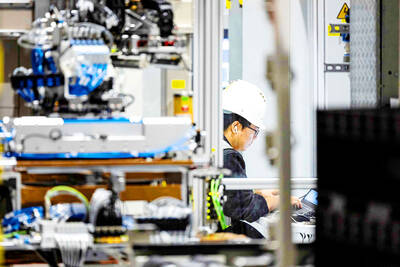The nation’s exports fell 9.7 percent from a month earlier to US$27.88 billion last month because of weaker seasonal demand for Taiwanese electronics and the shutdown of several plants at the sixth naphtha cracker complex, the Ministry of Finance said yesterday.
However, exports still grew 10.8 percent last month from a year earlier, with exports surging 16.9 percent year-on-year to US$154.14 billion in the first six months, the strongest level ever, the ministry’s data showed.
“The continuing strong momentum of Asian economies, and the robust demand from US and European countries for high-tech products made by local companies, drove up Taiwan’s exports in the first half of the year,” Lin Lee-jen (林麗貞), director of the statistics department, said at a media briefing.
Robust demand for smartphones and tablets made by Taiwanese companies helped boost exports in information and communications technology products to US$3.91 billion in the first six months, up 66.3 percent year-on-year, the highest growth among 10 sectors, Lin said.
Outbound shipments to China and Hong Kong, the US, Japan, Europe and ASEAN all hit a record high in the first half of the year, Lin said, adding that exports to ASEAN accounted for 16.4 percent of overall exports during the period, the highest level in history.
Looking forward to the second half of the year, rising uncertainties about the global economy — including fiscal tightening measures in emerging markets and the eurozone’s debt crisis — may slow the growth of exports, Lin said.
“However, the ministry remains optimistic that full-year exports will reach the government’s goal of US$310 billion, because the global economy is still in a recovery phase,” she said.
Imports surged 20.3 percent from a year earlier to US$144.07 billion in the first six months, also the highest on record, with imports of capital goods, consumer goods and agricultural and industrial raw materials all reaching a historic high, the ministry said.
Because imports grew faster than exports, the nation’s trade surplus fell 17.1 percent year-on-year to US$10.08 billion in the second half of the year, data showed.
“However, this may not hurt the nation’s competitiveness because the growth of imports mainly came from capital goods, a potentially good sign for an export-oriented country like Taiwan,” Lin said.
HSBC Greater China economist Donna Kwok (郭浩庄) also expects the growth in exports to improve in the third quarter on stronger demand.
“Last month’s exports was a disappointing result, but as supply disruptions fade, Japan reconstruction efforts kick in, China holds up and US demand reaccelerates, Taiwan’s electronics-driven trade flows will stabilize during the third quarter,” Kwok said in a note yesterday.

CHIP RACE: Three years of overbroad export controls drove foreign competitors to pursue their own AI chips, and ‘cost US taxpayers billions of dollars,’ Nvidia said China has figured out the US strategy for allowing it to buy Nvidia Corp’s H200s and is rejecting the artificial intelligence (AI) chip in favor of domestically developed semiconductors, White House AI adviser David Sacks said, citing news reports. US President Donald Trump on Monday said that he would allow shipments of Nvidia’s H200 chips to China, part of an administration effort backed by Sacks to challenge Chinese tech champions such as Huawei Technologies Co (華為) by bringing US competition to their home market. On Friday, Sacks signaled that he was uncertain about whether that approach would work. “They’re rejecting our chips,” Sacks

It is challenging to build infrastructure in much of Europe. Constrained budgets and polarized politics tend to undermine long-term projects, forcing officials to react to emergencies rather than plan for the future. Not in Austria. Today, the country is to officially open its Koralmbahn tunnel, the 5.9 billion euro (US$6.9 billion) centerpiece of a groundbreaking new railway that will eventually run from Poland’s Baltic coast to the Adriatic Sea, transforming travel within Austria and positioning the Alpine nation at the forefront of logistics in Europe. “It is Austria’s biggest socio-economic experiment in over a century,” said Eric Kirschner, an economist at Graz-based Joanneum

BUBBLE? Only a handful of companies are seeing rapid revenue growth and higher valuations, and it is not enough to call the AI trend a transformation, an analyst said Artificial intelligence (AI) is entering a more challenging phase next year as companies move beyond experimentation and begin demanding clear financial returns from a technology that has delivered big gains to only a small group of early adopters, PricewaterhouseCoopers (PwC) Taiwan said yesterday. Most organizations have been able to justify AI investments through cost recovery or modest efficiency gains, but few have achieved meaningful revenue growth or long-term competitive advantage, the consultancy said in its 2026 AI Business Predictions report. This growing performance gap is forcing executives to reconsider how AI is deployed across their organizations, it said. “Many companies

France is developing domestic production of electric vehicle (EV) batteries with an eye on industrial independence, but Asian experts are proving key in launching operations. In the Verkor factory outside the northern city of Dunkirk, which was inaugurated on Thursday, foreign specialists, notably from South Korea and Malaysia, are training the local staff. Verkor is the third battery gigafactory to open in northern France in a region that has become known as “Battery Valley.” At the Automotive Energy Supply Corp (AESC) factory near the city of Douai, where production has been under way for several months, Chinese engineers and technicians supervise French recruits. “They